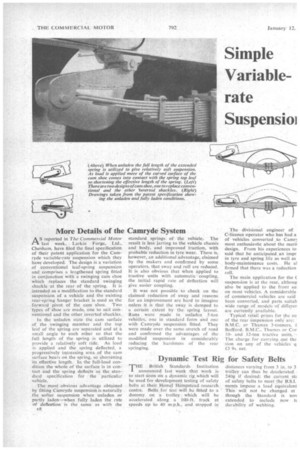More Details of the Camryde System
Page 64

If you've noticed an error in this article please click here to report it so we can fix it.
AS reported in The Commercial Motor last week, • Larkin Forge, Ltd., Chesham, have filed the final specification of their patent application for the Camryde variable-rate suspension which they have developed: The design is a variation of conventional leaf-spring suspension and comprises a lengthened spring fitted in conjunction with a swinging cam shoe which feplaces the standard swinging shackle -at the rear of the spring. It is intended as a modification to the standard suspension of a vehicle and the existing rear-spring hanger bracket is used as the forward pivot of the cam shoe. Two types of shoe are made, one to suit conventional and the other inverted shackles.
In the unladen state the cam surface of the swinging member and the top leaf of the spring are separated and at it small angle to each other so that the full length of the spring is Utilized to provide a relatively soft ride. As load is applied and the spring deflected, a progressively increasing area of the cam surface bears on the spring, so shortening its effective length. In the full-load condition the whole or the surface is in contact and the spring deflects as the standard specification for the particular vehicle.
The most obvious advantage obtained by fitting Camryde suspension is naturally the softer suspension when unladen or partly laden—when fully laden the rate of deflection is the same as with the
Eg
standard springs of the vehicle. The result is less jarring to the vehicle chassis and body, and improved traction, with probable reduction in tyre wear. There is, however, an additional advantage, claimed by the makers and confirmed by some operators, that sway and roll are reduced. It is also obvious that when applied to tractive units with automatic coupling, the initial rapid rate of deflection will give easier coupling.
it was not possible to check on the claimed reduction of sway and reasons for an improvement are hard to imagine unless it is that the sway is damped to a certain extent by the spring layout. Runs were made in unladen 5-ton vehicles, one in standard form and one with Camrydc suspension fitted. They were made over the same stretch of road and confirmed the advantages of the modified suspension in considerably reducing the harshness of the rear springing. The divisional engineer of C-licence operator who has had a of vehicles converted to Calmn most enthusiastic about the merit design. From his experiences to said that he anticipated an impr in tyre and spring life as well as body-maintenance costs. He al firmed that there was a reduction roil.
The main application for the ( suspension is at the rear, althoug also be applied to the front su: on most vehicles. A considerable of commercial vehicles are said been converted, and parts suitab wide range of models of differen arc currently available.
Typical retail prices for the co of the rear Suspension only are: B.M.C. or Thames 3-tonners, f. Bedford. B.M.C.. Thames or Cur 10and 12-ton tractive units.7: The charge for carrving.but the sion on any of the vehicles q £3 9s. net.








































































































































